Description
Genus: Neoboletus
- Genus 2: Boletus
- Genus 3: Sutorius
Species: discolor (in the sense of American authors, since the species name will change in the next few years. See the Science Notes)
- Species 2: subluridellus (probably where this will end up)
- Species 3: erythropus ssp. discolor
- Species 4: luridiformus ssp. discolor
- Species 5: chamaeleon (a provisional name used by Dr. Igor Safonov on Mushroom Observer)
Common Name: “Scarletina” or “Red Mouth Bolete”
Tells: Yellow/red cap bruises black. Yellow baby pores age to bright red & blue instantly. Yellow flesh blues instantly. Hugely variable yellow stem bruises blue-black.
Other Information: Pale yellow flesh quickly blues. Cap color starts yellow/orange but is immensely variable and subject to appearing darker because it bruises so easily. A common species from the Mason-Dixon line up. No netting distinguishes from B. luridus, & no red hairs at the stem base distinguishes from the hemlock loving Neoboletus subvelutipes. Neoboletus luridiformis has a darker cap and darker yellow flesh than discolor, but both of these species have enormous flexibility in how they appear, so expect to have cases where they can be confused for each other. The reported chemical tests are distinctly different for Ammonia and KOH, but experience has shown this to be unreliable.
Science Notes: The European species formerly known as Boletus discolor, and Boletus luridiformis, Boletus erythropus, and Boletus queletii have been merged into a single species that is now called Suillellus (probably Neoboletus) queletii. Boletes of Eastern North America follows this by merging the American “discolor“ into “luridiformis“ despite the European names, and using Neoboletus as the genus. BOENA keeps subluridellus, an American name, as a separate species while declining to move it over to Neoboletus. Whew. The bottom line is this: these are beautiful mushrooms with massive flexibility in how they appear, and the nomenclature is completely fouled up. It doesn’t help that different reactions to both Ammonia and KOH have been reported for the different color variations even when the DNA is identical. (Perhaps the reaction is with a changeable pigment?) In any case, this site plans to keep all three names (discolor, luridiformis and subluridellus) with separate entries until the mess gets cleared up by a proper article in a respected journal. Just be aware that the group will certainly be merged down into two species, and maybe even one mega-species. The name subluridellus will probably survive, but heaven alone can guess what the other will be. FWIW, DNA tests have now established that the hemlock loving B. subvelutipes really is a separate species even though it is hard to distinguish by morphology.
There is also some question about whether the Genus Suillellus should be merged with Neoboletus… but that is a whole different fight, lol. Suffice it to say they are close relatives. Stay tuned! Someday the science will give us clarity, and hopefully include the other hard-to-distinguish red pored, blue staining lookalikes such as B. subluridus, B. rufocinamomeus and B. flammans, the one now known as Suillellus luridus, the several moved to Rubroboletus, and the brown-pored blue-stainers vermiculosus and vermiculosoides. Wouldn’t that be nice?
Edibility: European sources say “delicious but must be thoroughly cooked.” Your author agrees, as did Gary Lincoff. With that said, Scarletinas remain on the “Iffy” list here rather than “Choice” because the traditional instruction in America was so clear: “Avoid the red-pored blue-stainers like this one unless you want to get sick.” That myth has now been destroyed, but we do not have the many decades of practical experience required to be 100% sure about things like individual sensitivities and the like. So I guess the bottom line would be this: “Choice, with cautions and maybe reservations.”
CHEMICAL TESTS:
- NH4OH (Ammonia): Cap surface yellow changes to dark slate and darker areas change to rusty brown. Cap flesh loses its blue staining.
- KOH: Cap surface (and stem) turns blood-red to rusty brown. Cap flesh turns orange to orange brown.
- FeSO4 (Iron Salts): Cap surface turns olive, but stem has no reaction. Cap flesh turns greenish olive.
Links:
 |
0 |  |
0 |  |
107 |  |
277 |

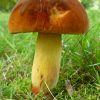

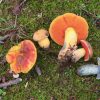
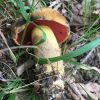
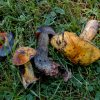
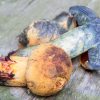

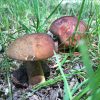
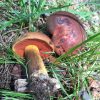
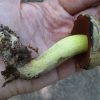
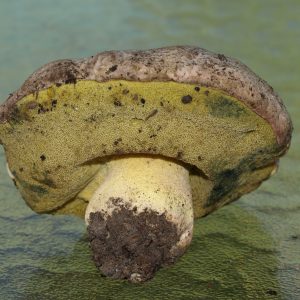
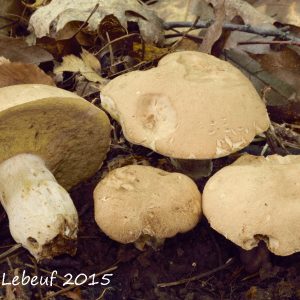
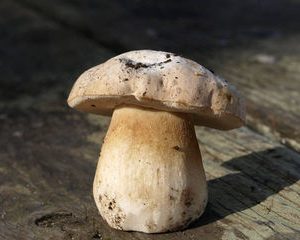
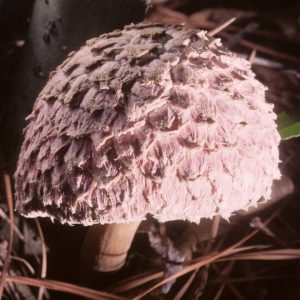
Got something to discuss?
What a cool, tasty bolete. I’m grateful that you updated the edibility section, I’d have probably never tried them otherwise.